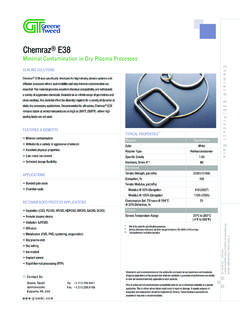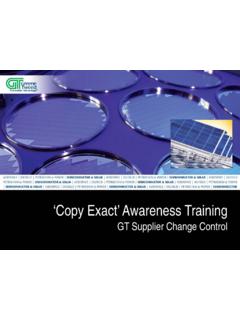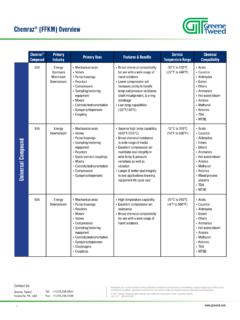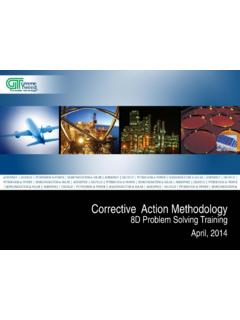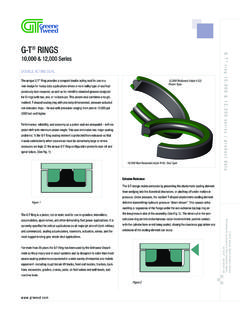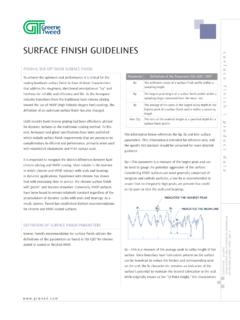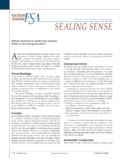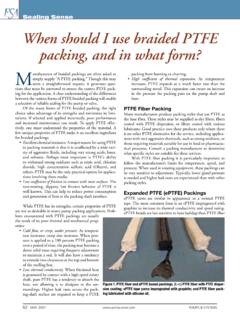Transcription of THE RIGHT SEAL - Greene Tweed
1 THERIGHTSEALYOURGUIDE TOSEALING TOSEALING , Tweed & of ContentsiIntroduction .. iiiChapter 1: Sealing Requirements in the Semiconductor Industry .. 1 Semiconductor Sealing Basics .. 1 Finite Element Analysis (FEA) .. 2 Semiconductor Manufacturing Requirements .. 3 Ultrapure Deionized Water Systems (UPDI) .. 3 Photolithography (Aqueous/Solvents) .. 4 Acids .. 5 Plasma Systems - Etch and CVD .. 6 Diffusion Systems .. 8 Flat Panel Display Manufacturing .. 8 New Process Areas .. 9 More Demanding Line Geometries .. 9 Cost of Success .. 9 Future Process Technologies .. 9 Chapter 2: Physical Properties of Elastomers .. 11 Fluid Resistance .. 11 Hardness .. 11 Toughness .. 12 Tensile Strength .. 12 Elongation .. 12 Compressive Force .. 12 Modulus .. 13 Tear Resistance.
2 13 Abrasion Resistance .. 13 Volume Change .. 13 Compression Set .. 14 Thermal Effects .. 14 High-Temperature .. 14 Low-Temperature .. 14 Resilience .. 15 Deterioration .. 15 Corrosion .. 15 Permeability .. 15 Coefficient of Friction.. 15 CONTENTST able of ContentsGreene, Tweed & of Thermal Expansion .. 16 Compression Stress Relaxation .. 16 Chapter 3: O-Ring Seals .. 17 How an O-Ring Works .. 17 Failure Modes of O-Rings .. 18O-Ring seal and Gland Design .. 21 Ordering Information .. 22 Chapter 4: Dovetail Seals .. 25 Ordering Information .. 26 Chapter 5: MSE Seals .. 29 How MSE Seals Work .. 29 Features and Benefits .. 29 MSE seal Types .. 31 Ordering Information .. 33 Gland Dimensions.. 34 Spring Materials .. 38 Jacket Materials .. 39 Hardware Surface Finish and Hardness Recommendations.
3 40 seal Installation and Installation Tools .. 40 Chapter 6: Specialty Applications.. 43 Bonded Gates .. 43 The Barrel seal .. 43 Custom Parts .. 44 Chapter 7: seal Gland Design .. 45 Static Face seal , Rectangular Gland, Internal Vacuum/External Pressure .. 45 Static Face seal , Rectangular Gland, Internal Pressure/External Vacuum .. 47 Static Face seal , Dovetail Gland, Any Pressure Combination .. 48 Static seal , Rectangular Gland, Any Pressure Combination .. 59 Dynamic seal , Rectangular Gland, Any Pressure Combination .. 69 Glossary .. 75 Semiconductor seal Compound Selection Guide .. InsertCONTENTS (continued) Greene , Tweed & anyone notices a critical seal until it fails costing literally hundreds of thousands of dollars in lostrevenue. While every seal will fail eventually, taking proper care in selection of materials and geometries canhelp you get a higher level of performance and longer, more predictablelife out of your purpose of this handbook is to help you avoid costly surprises.
4 We want to share with you what we atGreene, Tweed have learned over 135 years of sealing manufacture including more than ten years ofsolving the unique sealing problems of the semiconductor manufacturing industry. If we can help youincrease your yields or reduce your downtime or both the book has served its people contributed their expertise in the preparation of this handbook. A special acknowledgment,together with our thanks, goes to semiconductor industry experts Robert Matthews and Fred handbook provides detailed technical information about a variety of seal types and materials,specifically for the benefit of individuals who design equipment and select seals and sealing materials for thesemiconductor fabrication industry. Each of the seal designs and materials discussed in these pages has aproven track record in the complex and unforgiving applications encountered in semiconductor don t think of this as Greene , Tweed s handbook.
5 We want it to be your handbook. We want to knowhow you use this book, which parts you find most helpful, and which areas you d like to see sealing art frequently involves compromise. But one area in which we will never compromise is clearcommunication with our customers. I look forward to hearing from PainoPresidentGreene, Tweed & , Tweed & Sealing BasicsSealing elements used in semiconductorproduction equipment face challenges which areunique to the industry. These seals must performunder positive pressure and vacuum conditions, inharsh chemical environments and at extremelyhigh temperatures. Most important, they must notdeteriorate or in any way introduce contaminants(extractables or particles) into the processes inwhich they are seals found in semiconductor production(fabrication) equipment are precision , they are molded from elastomericmaterials or machined from plastics.
6 They aredesigned to create a barrier to the passage of fluids or gases within the systems or componentsin which they are used. This barrier, or sealingaction, is achieved by the seal material s ability to conform to, or mate closely with, the sealingsurfaces. It must do so while resisting the effects of chemical exposure, temperature, pressure, aging and cyclic motion, and without bonding to the sealing are three primary classifications of seal installations: Dynamic are installed onto surfaces that moverelative to each other. This relative motion can be reciprocating, oscillatory orrotary. Semi-dynamic are also installedonto mating surfaces that move relative toeach other in an elevator or up-downmotion. Seals of this type include Dovetail Seals (seals especially designed for use indovetail glandsor grooves) and lid seals.
7 Static are installed onto matingparts that do not moverelative to each , as a practical matter, most static seals doencounter movement, which can becaused by thermal expansion, vibration, seals are categorized according to the direction of the sealing force. There are two basic directions of sealing force: axialand each type of installation, the seal fits into agland or groove which has been incorporated intoone of the mating parts which close the gap or fillthe sealsare the most common type of sealfound in semiconductor production equipment. O-rings are torus-shaped elements that can readily be fabricated from high-performanceelastomers which are able to withstand the harshchemistries used in semiconductor production. O-rings are also produced from engineered plasticsand metals.
8 They are versatile, easy to use andrequire little types of standard (and even custom) sealdesigns are employed to meet the myriad sealingrequirements found in critical processes used toproduce semiconductor components. Sealingelements which are actually bonded to metalsurfaces, as opposed to being installed in a gland,are gaining popularity for such components as slitvalves. These bonded sealsperform with much lessmovement, resulting in significantly less particulationthan conventional dynamic and static action is achieved through the sealmaterial s ability to conform to, or mate closelywith, the microscopic peaks and valleys againstwhich it seals. To ensure constant leakback rates, sealing devices installed in semiconductorproduction processes must be able to conform to the sealing surfaces found on a wide rangeof materials.
9 These materials include a variety ofmetals, plastics and even the silicon being REQUIREMENTS IN SEMICONDUCTOR MANUFACTURINGG reene, Tweed & 11 The contacting surfaces play an important role inthe life of the dynamic seal . The designer mustcarefully consider the roughness of the surfaceswith which a seal will be in contact. This requiresfamiliarity with the techniques and measurementsused to determine surface roughness,and the resultsthat can be expected from the various methodsused to produce finishes. Generally, the mostdesirable surface roughness value is 8 to 16microinches (Ra) for dynamic seals. Static sealsshould have a surface roughness not exceeding 32microinches (Ra). Face-type (static) seals in gasapplications normally require a mating surfaceroughness value of 8 to 16 microinches (Ra).
10 Equally essential to proper sealing action insemiconductor fabrication equipment is the design of the seal /gland configuration. This designmust take into consideration not only surfacefinish, but stretch, squeeze, gland fill, installationand materials selection. We should emphasize thatthe semiconductor equipment designer will find itenormously helpful to include the seals supplier atthe outset of the design process. Finite Element AnalysisGreene, Tweed uses nonlinear Finite ElementAnalysis (FEA) extensively in all aspects of sealdesign and application. Using FEA, stress-strainand thermal analysis of complex structures can beChapter 1 Greene , Tweed & 1-1 Sealing ElementsGreene, Tweed & 13performed quickly and accurately. Because of theextremely large deformations that seals experience,traditional hand calculations are nearly impossibleto perform.
